Search: Lateral Hands Down 2 Channels
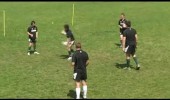 0:09
0:09
One handed passing down channel holding 2 balls
This drill allows you to develop control over the ball and the ability to pass one handed if needed to
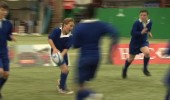 0:26
0:26
3 v 2 in Channel
A development of the 2 v 1 and 3 v1 drills, the attackers now must beat 2 defenders. This requires more decision-making ability as the movements of the defenders could change every time. Players must communicate as well as continue to perform their handling and running skills.
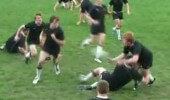 0:13
0:13
Offload out of the tackle with ball in 2 hands
Keeping the ball in two hands is a core skill and one that needs to be developed at ALL ages
To watch over 2500+ videos join now for free!
JOIN NOW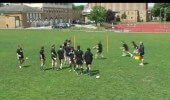 0:33
0:33
3 v 2 in channel
A good progression from the 2 v 1 drill
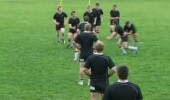 0:10
0:10
Offload out of the tackle in channel 2
A good progression for developing difficulty from a standard drill, look at carrying the ball and moving the defender so that you can ride the tackle
11. 6 v 2 v 2 v 2
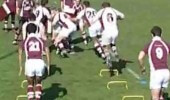 0:21
0:21
6 v 2 v 2 v 2 v 3
Developing the skills into decision making down a channel
Step 4 - Introducing the 2 v 2 Scrum
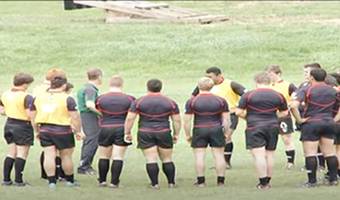 2:16
2:16
L2 - Outflanking Game
Skill Practice Description The objective of this game is to develop the ability to execute the 2 v 1 with consistent efficiency. • The attacking team initially has at least one extra players in order to create an advantage. • There is a channel on each wing in which only 1 defender and 2 attackers may enter at any time. • The attack works the play to get the ball into the outside channel then execute the 2 v 1. • With the extra players, the attack can also develop opportunities to penetrate the defence and so the game in not relying on lateral moment and still incorporates the principles of ‘go forward’. • The progression is to remove the cones and see if the players can still take advantage of the 2 v 1 without the conditions set within the channelled areas . • A further progression would be to even the numbers of each team. Key Coaching Points • Running lines to condense and hold defences in order to outflank. • Running lines in order to disrupt and penetrate the defence line. Relevance to the Game • Attacking players often fail to fix defenders effectively and may drift or over elaborate. • This game will assist in angles of run that fix the last defender
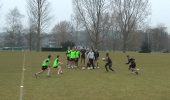 2:59
2:59
Quins Defence - 2 v 2 tackling
A progression from the 1 v 1 drill this exercise adds extra players to make the decision making process more realistic. The coaches can vary the delivery of the ball and the width of the area to put different conditions to the players
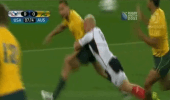 0:15
0:15
Men's - Offloads 2
A counter attack invlving moving the ball wide quickly, then attack defenders with support runners and finally a 2 v 1 to score in the corner. Key factors : Strong communication - Wide spin passes - Attacking the space around defenders - Support the ball carrier from behind - Offload with two hands - straight running - Flat pass
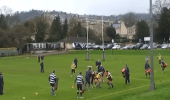 1:03
1:03
Offloads through contact then lateral pass
In groups of 4, players must support each other through a tight channel of tackle shields, before panning out to complete lateral passes to the wing.
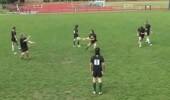 0:13
0:13
Lateral passing in 3s (SM)
A simple lateral passing exercise for all standards. These basic skills are fundamental to rugby and should be repeated using a number of different practises. Key factors : Communication - Present a target with your hands - Run straight - Pass the ball across your body - Realign to repeat
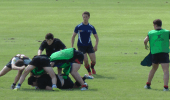 2:15
2:15
Turnover session - 2 Games
A full contact game, conditioned with channels on either side of the pitch. The attacking team must get the ball to both channels before they are allowed to score a try.
This is to spread the attack out, and create more opportunities for turnover ball to occur
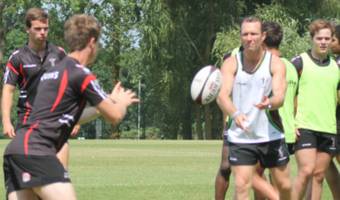 3:05
3:05
3 v 2 How to Fix Defenders
Running straight & fixing defenders is a skill that all players must learn and learn at an early age. The top players regularly practise this skill to maintain accuracy. This is the building block to scoring tries
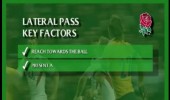 1:12
1:12
Key factors of the lateral pass
An introduction to coaching the lateral pass
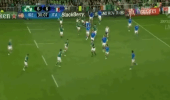 0:18
0:18
Men's - Turnover and move the ball 2
Strong defence and a turnover allows two quick passes, (One long pass), and then attack the defence. The two passes have changed the channel of attack by 30 metres.
Key factors : Tackle and stay on your feet - Long quick pass / spin pass - Communicate loudly - Support the ball carrier on his shoulder
Level 2 - Binding on to the Opposition
This video illustrates binding options for the props.
The tight head tries to get their hand in line with their face.
The loose head has a short arm and a long arm option
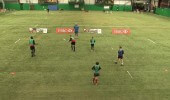 0:28
0:28
3 v 1 in Channel
A progression from the 2 v 1, where a second pass is encouraged to move the ball away from the defender.
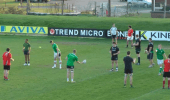 0:36
0:36
Learning to spin pass 2
A progression to build passing technique. The ball should be pushed from the waist rather than the player swinging the arm back first. Push through the ball so your arm finishes pointing at your target. Don't forget to practice on both hands.
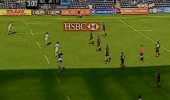 0:24
0:24
Sevens - Offloads 2
To execute an offload you need to have support players in the right area, here the ball carrier knows he has support and is able to take a risk and offload out of the back of the tackle. Prior to the offload the ball carrier works hard to stay on his feet. Key factor : Leg drive - Twist and work the body in contact - Control ball one handed - Communication from support players
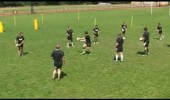 0:21
0:21
Catch & Pass down channel
A core skill that needs constant development and practise Key Factors : Communicate loudly - Present a target with your hands - Run straight - Pass the ball across your body - Use wrists to keep the ball on a flat level - Move back ready to repeat
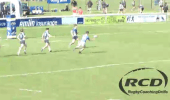 0:28
0:28
Simple hands beat Bunched Defence
When a defensive line is 'bunched up', a single pass can take several defenders out of the game. Here, Richard Hale benefit from a bunched Filton College defence, executing lateral passes along the line to attack space out wide.
Level 2 - Scrum Body Positions
Level 2 - Scrum Body Positions
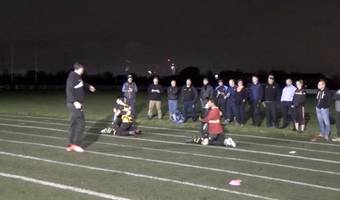 3:46
3:46
Functional Movement Warm Up Part 2
Every player should be able to perform these movements well! Mastering these will carry over to preventing injuries, managing collisions and maximising power and speed. Check out the related videos for part 1.
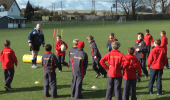 2:15
2:15
Passing - 3 v 2 Live Defenders
Gradually progress from 2 static defenders, to 3 v 2 roaming defenders. The first two players must draw their defenders before giving the pass.
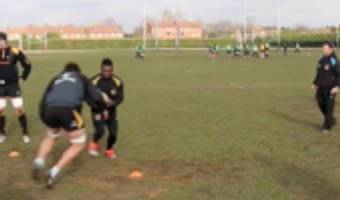 1:33
1:33
Scrum Factory - 11. Flanker Channeling and The Role of the Number 8
The roles of each player in channelling the ball to the number 8
 3:21
3:21
Three Channel Passing Challenge
Adding pressure to key skills is crucial to improve your players and to practise like you play. This exercise covers a variety of skills but essentially is about accurate passing and fixing defenders
 0:23
0:23
Junior - 2 v 1 2
Junior - 2 v 1 2
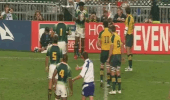 0:31
0:31
Sevens - Full Lineout 2
Sevens - Full Lineout 2
 0:41
0:41
Learning to pass laterally in 4's
Developing our lateral passing skills. The coach can alter the width, depth and number of players
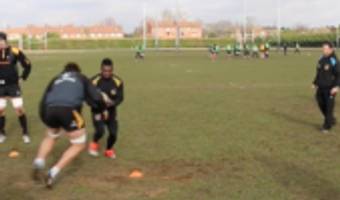 2:18
2:18
Tackling 20 - 2-man Tackle
Tackling 20 - 2 man Tackle
Tackling 2 - Rugby Kibadi
Level 2 - Second Row Bind - Traditional Bind
Level 2 - Second Row Bind - Traditional Bind
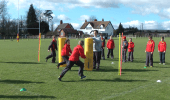 1:16
1:16
Passing - 3 v 2 Static Defenders
Progress to working in 3s against two static defenders. The pressure is on the middle player to hold their depth and perform a quick pass.
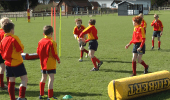 2:09
2:09
Lateral Passing in 3s
A quick exercise to identify ability in catching & passing. Encourage players to have targets up, and to hold their run.
Level 2 - Back Row Example Clip 2

Junior - 3 v 2 2

Women's - 2 v 3 2
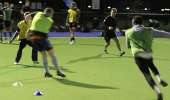 2:40
2:40
Two Channel Passing Exercise
Players work in 3s running around the corner and realigning to attack. Introduce defenders and the need to look up and communicate.
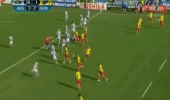 0:20
0:20
Men's - 3 v 2 2
Level 2 - Second Row Bind - Walk Around Bind
2. Tig

Sevens - 2 v 1 2
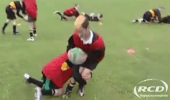 1:20
1:20
Introduction to tackling - Step 2
The transition from practicing tackling on knees to tackling on feet starts with the tackler remaining on their knees and the ball-carrier walking past. Then progress to having both players on their feet, but still executing the tackle at a controlled, walking pace.
Good Practice - Segment 2
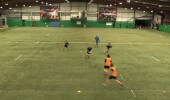 0:34
0:34
3v2 in Channel
A simple yet effective drill that enables players to test out their attacking options. They must attempt to control the situation by committing one defender, to create the 2v1.
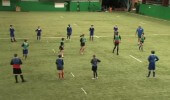 0:47
0:47
Lateral Pass in 5s
This simple drill breaks down the catch and pass while running in a straight line. Players also practice their communication skills.
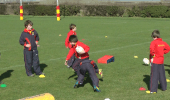 2:24
2:24
1 v 1 Tackling in Channel
An opportunity for players to put what they have learnt on tackle technique into practice. Each tackle is observed by all other players who can give feedback. Ensure all players have a go at attacking and defending.
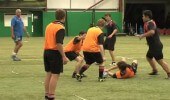 1:57
1:57
5v5 Semi-contact (2)
The sides are now even and the players can tackle, but not attempt to steal the ball. Again, the defence must retreat 5m, giving the attackers opportunities.
11. 4 v 2 Continuous Touch Rugby
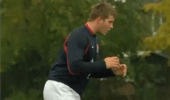 1:21
1:21
Tackle Technique - Boxer's Hands
Players should have their hands up ready, so they can wrap around when making a tackle.
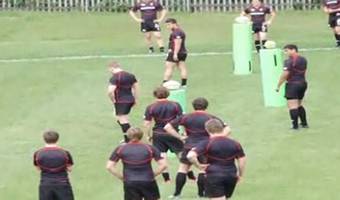 2:53
2:53
L2 - Conditioning Circuit
Using the full length of the pitch the practice is a continuous 3 v 2 scenario. • 3 attackers knock over a bag to collect a ball and attack 2 defenders in the 5m channel. • If they fail to beat the defenders (touch/grip), the attackers run back to knock over another bag and start again. • Having beaten the first defenders they carry on with the same ball to beat 2 further defenders who may choose a colour and start from the appropriate cone. • If the attackers fail to beat the defence they run back to the bag and start again with another ball. The defence can choose another colour to start from. • The next challenge is two free roaming defenders. If the attack fail they go back and knock over another bag to start again. • Finally the defenders choose a colour to start from and if the attack fail they get another ball and the defence choose another starting colour. • The objective is to complete the attack with the starting ball and restarts. Keep score to create competition
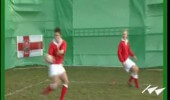 0:37
0:37
What is a lateral pass
To develop the lateral passing and take a look at the fundamental movements
 1:22
1:22
Skills at home - Quick hands game
"Quick hands" is a term used regularly in rugby and relates to a players ability to move the ball quickly. This fun exercise pressures one player to move two balls in different directions
 2:52
2:52
Lineout Lifting Hand Placement
This video takes you through the importance of hand placement in building a solid lineout.
Tackling 5 - 'Boxer Hands' and Arms
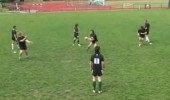
Lateral passing in 3s
Core skills development of teh lateral pass whgilst running
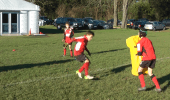 1:04
1:04
Tackle Technique in channel
Use a channel with attackers and defenders to progress the tackle technique, mix the players up so they all have opportunities. Reinforce the coaching points and give praise regularly
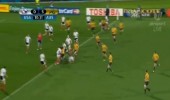 0:17
0:17
Men's - 2 v 1
A good example of phase play to create a 2 v 1 attacking platform. The initial deep pass then creates an overlap and the defender drifts to allow the attacker to run through easily.
Key factors : Quick ball at breakdown - Straight lines of running - Deep pass - straight lines of running again - Loud communication
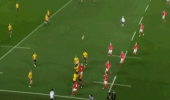 0:21
0:21
Men's - Standard restart with good catch 2
Men's - Standard restart with good catch 2
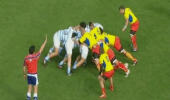 0:19
0:19
Men's - Lineout maul good defence 2
Men's - Lineout maul good defence 2
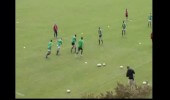 0:48
0:48
Lions - Attacking channells
From the Lions 2009 tour, a support drill in a channel to encourage the ball carrier to move the defender and make space for the support player
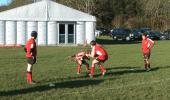 1:26
1:26
Live tacking in channel
Finally introduce live 1 v 1 tackling in a controlled environment using a channel. Standards will vary but as coaches it is important to praise all of the players. Doing this exercise too early may cause problems and refrain from doing so until the fundamental skills have mastered
 0:20
0:20
Junior - Wrap Tackle 2
Junior - Wrap Tackle 2
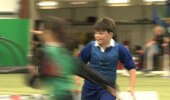 0:28
0:28
2 v 1 Draw and Pass
A basic 2 v 1 drill that encourages players to time their pass after they have drawn a defender, and for the supporting player to hold their depth.
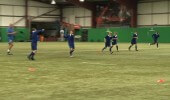
Lateral Pass Variations
Here are different ways to develop a basic lateral pass exercise. Either increase the amount of players, or ask them to start from different positions.
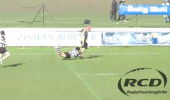 0:29
0:29
Evasion Skills - Hand-off
Hand-offs can be an extremely effective attacking tool, particularly in sevens where there are fewer defenders to beat. Here, a player from Stowe School performs two to complete an 85m run-in. Using a strong, outstretched arm keeps the defender at a safe distance.
 0:20
0:20
Women's - Exiting the 22m 2
Women's - Exiting the 22m 2
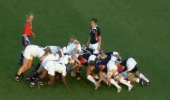 0:16
0:16
Women's - Straight Scrums 2
Women's - Straight Scrums 2
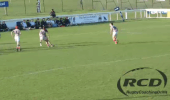
Sevens - 2 v 1
Having identified a 2 v 1 situation, the RGS Guildford player decides not to give an early pass from the breakdown, but instead to run and commit the defender before giving a pass to his teammate. Key factors: Timing - communication - accurate passing
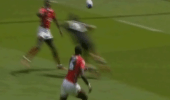
Sevens - 2 v 1
A variety of passes create a 2 v 1 which is executed perfectly for the outside attacker to score. Key factors : Different angles of running and support - Comunication - Ball presentation - Effective clearing of defenders at the breakdown - Accurate wide passes - Attack the inside shoulder of the last defender - Flat spin pass
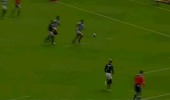
Sevens - 2 v 1
Seven's is about creating chances and then taking them. In this clip the Blue team take the ball up the middle of the pitch to draw in defenders, after recycling the ball they have a 2 v 1 opportunity, a straight line of running and a flat wide pass creates the try. Key factors : Call early - Run straight - Wide spin pass - Catch and swerve to score
 0:38
0:38
Women's - Good contact body position/ball presentation 2
Women's - Good contact body position/ball presentation 2
 0:25
0:25
Junior - 2 v 1 1
Junior - 2 v 1 1
 0:15
0:15
Women's - 2 v 3 1
Women's - 2 v 3 1

Women's - 2 v 1
Women's - 2 v 1
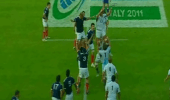 0:17
0:17
Junior - Ball off the top from lineout 2
Junior - Ball off the top from lineout 2
 0:15
0:15
Women's - Offloads 2
Women's - Offloads 2
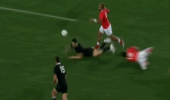 0:15
0:15
Men's - Offloads for Continuity 2
Men's - Offloads for Continuity 2
 0:16
0:16
Men's - Good body position in contact & ball presentation 2
Men's - Good body position in contact & ball presentation 2
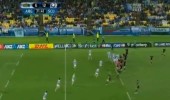 0:19
0:19
Men's - 3 v 2 1
A passage of play that shows how to attack with more attackers than defenders, a 3 v 2. The winger shows that strong running and determination can break tackles. Click on the practises in this section for coaching ideas
 0:19
0:19
Men's - Exiting the 22m 2
Men's - Exiting the 22m 2
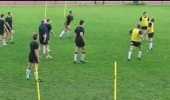 0:27
0:27
One handed passing touch
Here the aim is for the player to pass the ball one-handed to support once they are touched.
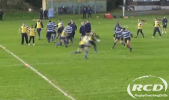 0:46
0:46
3 v 2 and then another defender
Develop decision-making skills in attack. 3 attackers must beat 2 defenders, before facing a third immediately after.
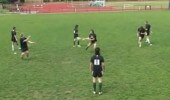 0:21
0:21
Lateral passing in 3s with a switch
A core passing exercise for developing the lateral passing drill
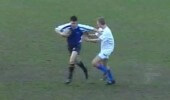 0:05
0:05
Hand off
An essential core skill in attack, the hand-off is particularly useful for wingers, who may have just one final defender to beat.
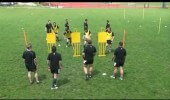 0:30
0:30
Pulling the pass back off left hand
Pulling the ball back off both hands is essential to being able to attack at pace
Level 2 - Back Row Example Clip 1
Level 2 - Back Row Example Clip 1
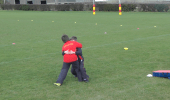 2:04
2:04
Get in Close - Boxers Hands
Exercises aimed at getting players to get close in before making tackles.
Chapter 2 - Introducing Competition for the Ball
Step 2 - Introducing Competition for the Ball
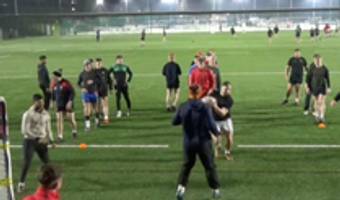 1:53
1:53
Quick Hands Primer
Divide the group into 4 and ask them to stand in single file behind each cone, 3 attacking groups, 1 defending group.
L2 - Penetrating Defence Game
Skill Practice Description • The playing area is marked out in 5m channels. • When defending, players must stay within their channel throughout the game. • The attack must look to penetrate the defence by creating and preserving space. • The defence must use a two handed touch. • There is a 5 tackle turnover rule and once possession is turned over, the defence must get into a channel as the opposition can attack immediately. Key Coaching Points • Support players to hold their opposite number as long as possible before cutting a line to take the pass. • The defender can close the space as far as the edge of their own channel. • If the support player cuts too early or the ball carrier does not move their defender enough, the support player will be touched/tackled. Relevance to the Game • This game will help develop the footwork and running lines to effectively move defenders in order to penetrate the tackle line.
Level 2 - Back Row Example Clip 4

Junior - Good contact body position/ball presentation 2
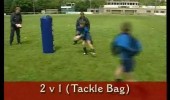
Learning to pass 2 v 1
Developing lines of running to attack the inside shoulder of defenders
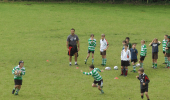 1:00
1:00
Attack 2 v 1
A good decision-making exercise which requires players to practice their basic running and passing skills
 0:56
0:56
Men's - Patterns of play 2


